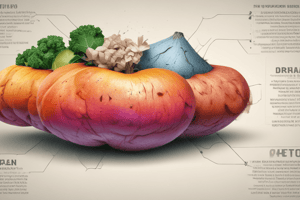Podcast
Questions and Answers
What is the definition of obesity?
What is the definition of obesity?
Excessive accumulation of body fat.
What are some challenges of measuring body composition?
What are some challenges of measuring body composition?
- Cost (correct)
- Equipment (correct)
- Tool accuracy (correct)
- All of the above
A body fat percentage greater than 22% is considered healthy for men.
A body fat percentage greater than 22% is considered healthy for men.
False (B)
Which of the following are physical indicators for evaluating obesity? (Select all that apply)
Which of the following are physical indicators for evaluating obesity? (Select all that apply)
Which of the following diseases or risk factors are associated with obesity? (Select all that apply)
Which of the following diseases or risk factors are associated with obesity? (Select all that apply)
What does BMI describe?
What does BMI describe?
What is the formula for calculating BMI?
What is the formula for calculating BMI?
BMI shows body fat composition and where fat is stored.
BMI shows body fat composition and where fat is stored.
What BMI range is considered underweight?
What BMI range is considered underweight?
What BMI range is considered obese?
What BMI range is considered obese?
Approximately 71% of individuals in the U.S. are considered obese or overweight.
Approximately 71% of individuals in the U.S. are considered obese or overweight.
About 42% of individuals in the U.S. are considered obese.
About 42% of individuals in the U.S. are considered obese.
What does waist circumference measure?
What does waist circumference measure?
A waist circumference greater than 102 cm (40 inches) is considered a risk factor for men.
A waist circumference greater than 102 cm (40 inches) is considered a risk factor for men.
A waist circumference greater than 88 cm (35 inches) is considered a risk factor for women.
A waist circumference greater than 88 cm (35 inches) is considered a risk factor for women.
What is visceral fat?
What is visceral fat?
What is subcutaneous fat?
What is subcutaneous fat?
What are adipokines?
What are adipokines?
What do adipokines do in the body?
What do adipokines do in the body?
What can central obesity do to adipokines?
What can central obesity do to adipokines?
What is insulin resistance?
What is insulin resistance?
Which of the following are forces that contribute to obesity? (Select all that apply)
Which of the following are forces that contribute to obesity? (Select all that apply)
Give an example of 'energy in'.
Give an example of 'energy in'.
What are estimated energy requirements?
What are estimated energy requirements?
What are estimated energy requirements based on? (Select all that apply)
What are estimated energy requirements based on? (Select all that apply)
What 'controls' energy in?
What 'controls' energy in?
What hormone controls hunger?
What hormone controls hunger?
What hormone controls satiety?
What hormone controls satiety?
What is the breakdown of estimated energy expenditure? (Select all that apply)
What is the breakdown of estimated energy expenditure? (Select all that apply)
What factors affect metabolic rate? (Select all that apply)
What factors affect metabolic rate? (Select all that apply)
What are ways to achieve weight maintenance or weight loss? (Select all that apply)
What are ways to achieve weight maintenance or weight loss? (Select all that apply)
What are some physical activity benefits beyond weight management? (Select all that apply)
What are some physical activity benefits beyond weight management? (Select all that apply)
What are modifiable risk factors for heart disease? (Select all that apply)
What are modifiable risk factors for heart disease? (Select all that apply)
Which risk factors for heart disease are affected by diet? (Select all that apply)
Which risk factors for heart disease are affected by diet? (Select all that apply)
What is the healthy cholesterol guideline?
What is the healthy cholesterol guideline?
What is the borderline cholesterol guideline?
What is the borderline cholesterol guideline?
What is the near optimal cholesterol guideline?
What is the near optimal cholesterol guideline?
What is the near optimal HDL guideline?
What is the near optimal HDL guideline?
What is the borderline HDL guideline?
What is the borderline HDL guideline?
What is the unhealthy HDL guideline?
What is the unhealthy HDL guideline?
Flashcards
Obesity
Obesity
excessive accumulation of body fat
What are the challenges to measuring body composition?
What are the challenges to measuring body composition?
cost, equipment, tool accuracy
Men's body fat percentage
Men's body fat percentage
greater than 22% body fat
Women's body fat percentage
Women's body fat percentage
Signup and view all the flashcards
Two physical indicators for evaluating obesity
Two physical indicators for evaluating obesity
Signup and view all the flashcards
Diseases and risk factors of obesity
Diseases and risk factors of obesity
Signup and view all the flashcards
BMI
BMI
Signup and view all the flashcards
Calculations for BMI
Calculations for BMI
Signup and view all the flashcards
What does BMI not show?
What does BMI not show?
Signup and view all the flashcards
Underweight BMI
Underweight BMI
Signup and view all the flashcards
Obese BMI
Obese BMI
Signup and view all the flashcards
What percentage of people are in the obese or overweight category?
What percentage of people are in the obese or overweight category?
Signup and view all the flashcards
What percentage of people are in the obese category?
What percentage of people are in the obese category?
Signup and view all the flashcards
What does waist circumference measure?
What does waist circumference measure?
Signup and view all the flashcards
Men's cutoff for waist circumference
Men's cutoff for waist circumference
Signup and view all the flashcards
Women's cutoff for waist circumference
Women's cutoff for waist circumference
Signup and view all the flashcards
Visceral fat
Visceral fat
Signup and view all the flashcards
Subcutaneous fat
Subcutaneous fat
Signup and view all the flashcards
Adipokines
Adipokines
Signup and view all the flashcards
What do adipokines do?
What do adipokines do?
Signup and view all the flashcards
What can central obesity do to adipokines?
What can central obesity do to adipokines?
Signup and view all the flashcards
Insulin resistance
Insulin resistance
Signup and view all the flashcards
Forces of obesity
Forces of obesity
Signup and view all the flashcards
Example of energy in
Example of energy in
Signup and view all the flashcards
Estimated energy requirements
Estimated energy requirements
Signup and view all the flashcards
What is estimated energy requirements based on?
What is estimated energy requirements based on?
Signup and view all the flashcards
Energy in "controls"
Energy in "controls"
Signup and view all the flashcards
What hormone controls hunger?
What hormone controls hunger?
Signup and view all the flashcards
What hormone controls satiety?
What hormone controls satiety?
Signup and view all the flashcards
Example of energy out
Example of energy out
Signup and view all the flashcards
Breakdown of estimated energy expenditure
Breakdown of estimated energy expenditure
Signup and view all the flashcards
Factors that affect metabolic rate
Factors that affect metabolic rate
Signup and view all the flashcards
How can you achieve weight maintenance or weight loss?
How can you achieve weight maintenance or weight loss?
Signup and view all the flashcards
Study Notes
Obesity
- Excessive accumulation of body fat
- Challenges in measuring body composition include cost, equipment limitations, and tool accuracy.
Body Composition
- Men with more than 22% body fat are considered having more body fat.
- Women with more than 32% body fat are considered having more body fat.
Evaluating Obesity
- Body Mass Index (BMI) and waist circumference indicate obesity levels.
Diseases and Risk Factors
- Obesity is linked to several illnesses and risk factors: Cardiovascular disease, dyslipidemia, hypertension, prediabetes, type 2 diabetes, and nonalcoholic fatty liver disease.
BMI (Body Mass Index)
- BMI describes relative weight for height.
BMI Calculation
- BMI is calculated by dividing weight (kg) by height (meters) squared.
Limitations of BMI
- BMI doesn't show body composition or fat distribution.
BMI Categories (not in the original text but inferred)
Prevalence of Obesity and Overweight
- 71% of the population is obese or overweight.
- 42% fall into the obese category.
Waist Circumference
- Measures central obesity, specifically fat around the abdominal region.
- High levels indicate heightened health risks.
Waist Circumference Cutoffs (in cm and inches)
- Men: Greater than 102 cm (40 inches)
- Women: Greater than 88 cm (35 inches)
Fat Types
- Visceral fat: Fat around organs.
- Subcutaneous fat: Fat under the skin.
Adipokines
- Proteins produced by adipose tissue, acting as hormones.
- Regulate inflammation and energy metabolism in various tissues.
Adipokines and Central Obesity
- Increased central obesity can potentially alter adipokines, leading to increased inflammation and insulin resistance.
Insulin Resistance
- Cells' reduced responsiveness to insulin.
Forces Contributing to Obesity
- Environmental cues, physiological factors, genetic predisposition, lifestyle choices, built environment, social influences, and economic factors play a role in obesity development.
Energy Balance
- Estimated Energy Requirements (EER): Average energy intake predicted to maintain body weight in healthy individuals, based on sex, age, physical activity, height, and weight.
Hunger and Satiety
- Ghrelin: Hormone stimulating hunger.
- Leptin: Hormone promoting satiety, feeling full.
Energy Expenditure
- Estimated Energy Expenditure (EE): The breakdown consists of basal metabolic rate (50-65%), thermic food effect (5-10%), and physical activity (25-50%).
Factors Affecting Metabolic Rate
- Factors impacting metabolic rate include: age, height, growth, body composition, fever, stress, fasting/starvation, and thyroxine levels.
Achieving Weight Management
- Weight maintenance or loss can be achieved through dietary adjustments, exercise, and overall lifestyle changes.
Physical Activity Benefits
- Beyond weight control, physical activity enhances cardiovascular function, improves dyslipidemia, increases HDL ("good") cholesterol, reduces blood pressure, and lowers mortality risk.
Modifiable and Non-Modifiable Risks for Heart Disease
- Modifiable: Smoking, alcohol consumption, physical inactivity, diet.
- Non-modifiable: Family history, age, sex.
Diet and Risk Factors
- Dietary factors influence high blood pressure, obesity, insulin resistance, type 2 diabetes, and dyslipidemia (abnormal blood fats).
Lipid Profiles
- Healthy cholesterol level is below 200 mg/dL
- Borderline: 200-239 mg/dL
- Unhealthy: Above 240 mg/dL
- Healthy LDL: below 160 mg/dl, >190 VERY HIGH RISK.
- Healthy HDL: above 60 mg/dL (Values for borderline and near-optimal HDL are given, but not for LDL)
Studying That Suits You
Use AI to generate personalized quizzes and flashcards to suit your learning preferences.




